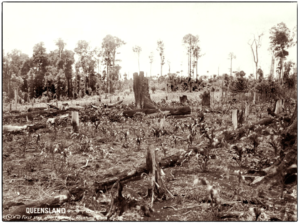Rosewood History

First step after clearing. Planting corn. 1890s

INDUSTRY
The production and supply of goods.
AGRICULTURE
APIARIST – William Perrem, Walter Bunney, J. W. Evans
COTTON GROWING – F. Moore, Alexander Grant, J. A Geiger, H. Jacobs, M. Ratz, J. Armstrong, John Grant, Thomas Hates, J. A. Neder, J. Platz, Werner, Sorhl, Shoefelot, B. Williams, Deringer, Samuel Dickens, W. Kraatz, C.Ballin, Geo Steele, J. P. Walsh, Samuel Waight, W. R. V. Leeson, John Yates, Henry Jacobs, John Henry Jacobs, Walter Power, August Linman, Ernest Weiland, Francis McKeon, John Hughes, James Madden, Patrick Moore, Patrick Hogan, Matthew Toohey, Martin Carmody, Michael, Kelly, J. Mullis, Patrick O’Keefe, John Cook, Denis Dwyer, Dennis Creedy, Robert Johnstone, James McAuliffe, Richard Andrew, Edward Pender. W. H. Schimke, F. A. Kingston, William Yarrow, G. Rackley, W. G. Hornick, C. Singleton, Collins, Martin Beavis, T. Harding , J. C. Johnston, L. Littman, J. Logan, H. Hannant, A. Schmidt, J. North, A. Waters, W. Greet, Walter Bunney, Farrelly, P. Cannon, August Miller, Paul Fischer
CROP FARMING
SMALL CROP FARMING
DAIRY FARMING
As the valuable timber was cut out of the scrub, the land had to be put to some productive purpose. So the scrub was felled, and the period of the farmer and the dairyman was ushered in. At first the dairyman milked a few non-descript cows obtained probably from a cattle station and put hand made butter on the market. But in the course of time it was found that if dairying was to pay there must be specialisation in the industry. The Rosewood district was the first to introduce co-operative methods in the butter industry. Cream separators, milk depots, and butter factories gradually became established institutions. The beef-cow of the cattle station gave place to a type more suitable for dairying purposes. In these processes of evolution towards scientific farming and dairying Rosewood has taken a worthy place. [Queensland Times, Monday 5 January 1914, page 4]
- BUTTER FACTORY – Messrs. F. C. Emmott and Co., Lanefield. (F. C. Emmott & M. Bensley), Rosewood Farmers’ Butter Factory (Rosewood Co-op)
- CHEESE FACTORY – W. Ruhno; Rosevale Cheese Factory
- CREAMERY – Lanefield Dairy Co., Rosewood Co-op Dairy Co., Mt Walker Co-op Dairy Co., Rosewood Farmers’ Butter Factory, Pommer Bros, Ben Meissner; Patrick Ahearn; Edward Collins
- DAIRY COMPANY – Rosewood Co-op Dairy Co., Lanefield Farmers’ Co-operative Dairy Co., Silverwood Dairy Co., Mt Walker Co-op Dairy Co.
FLOWER GROWING – Mrs Bunney
FRUIT GROWING – C. Dutney, James Jacobs, John Freeman, G. Harding, F. G. Fuchs
GRAPE GROWING – John Freeman, Geo S. Lambert (Mt Walker Vineyard), Henry McGeary
MARKET GARDENER – William Mathew, Oscar Bensley
POULTRY FARM – John Heiner, Harold Fraser, Ernest James Blake (Sunnyville Poultry Farm)
SUGAR GROWING
- SUGAR MILL – Woodlands Sugar Mill, Marburg
MINING
COAL MINING
SAWMILLING
In the early days the Rosewood Scrub was a large area, thickly covered with pine, cedar, and other valuable timbers. Around the scrub were fertile forest lands suitable for agricultural and grazing purposes. The timber-getters and the small selectors who reared a few cattle and did odd jobs were the pioneers of the localitys. The Rosewood Scrub timber supplied material for many of the buildings in lpswich, Brisbane, and farther afield. It secured an excellent reputation, because the trees were large and matured, and the quality of the timber, therefore was very durable. The early timber-getters and small selectors led a strenuous life. In many instances they had to put up with considerable privations. Their work was to subdue the wilderness in lonely places. But in many ways it was a life of glorious freedom. [Queensland Times, Monday 5 January 1914, page 4]
ROSEWOOD MILLS
First Mill
- Collett Bros. (Proprietor)
- H. Woodford (Proprietor)
Second Mill
- Richmond River Timber Co. (Proprietor) – C. Runge, Wohlgemuth & Spann, James O’Shea, E. A. Maher, Boyle & Atkinson
- Rosewood Colliery (Proprietor)
- Allan Joynson (Proprietor)

Boy milking a cow at the Convent, Rosewood, 1920s
© Jane Schy, 2024
